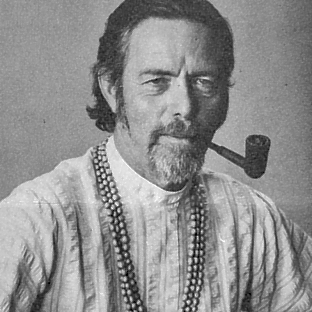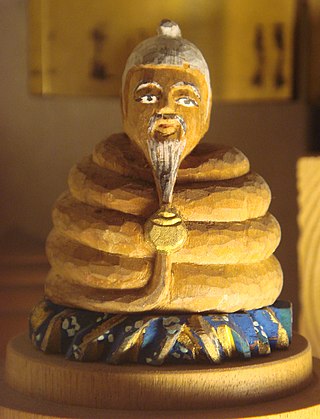
Budai is a nickname given to the historical Chinese monk Qieci in the Later Liang Dynasty, who is often identified with and venerated as the future or Maitreya Buddha in Chan Buddhism and Buddhist scripture. With the spread of Chan Buddhism, he also came to be venerated in Vietnam, Korea, and Japan. Budai is said to have lived around the 10th century CE in the Wuyue kingdom.

Alan Wilson Watts was a British and American writer, speaker, and self-styled "philosophical entertainer", known for interpreting and popularising Buddhist, Taoist, and Hindu philosophy for a Western audience.

Buddhism was first established in Japan in the 6th century CE. Most of the Japanese Buddhists belong to new schools of Buddhism which were established in the Kamakura period (1185-1333). During the Edo (Tokugawa)-period (1603–1868), Buddhism was controlled by the feudal Shogunate. The Meiji-period (1868–1912) saw a strong response against Buddhism, with persecution and a forced separation between Buddhism and Shinto.

Acala or Achala, also known as Acalanātha or Āryācalanātha, is a wrathful deity and dharmapala prominent in Vajrayana Buddhism and East Asian Buddhism.

Niō (仁王) are two wrathful and muscular guardians of the Buddha standing today at the entrance of many Buddhist temples in East Asian Buddhism in the form of frightening wrestler-like statues. They are dharmapala manifestations of the bodhisattva Vajrapāṇi, the oldest and most powerful of the Mahayana Buddhist pantheon. According to scriptures like the Pāli Canon as well as the Ambaṭṭha Sutta, they travelled with Gautama Buddha to protect him. Within the generally pacifist tradition of Buddhism, stories of dharmapalas justified the use of physical force to protect cherished values and beliefs against evil. They are also seen as a manifestation of Mahasthamaprapta, the bodhisattva of power that flanks Amitābha in Pure Land Buddhism and as Vajrasattva in Tibetan Buddhism.

The Greco-Buddhist art or Gandhara art is the artistic manifestation of Greco-Buddhism, a cultural syncretism between Ancient Greek art and Buddhism. It had mainly evolved in the ancient region of Gandhara, located in the northwestern fringe of the Indian subcontinent.

Buddhism includes a wide array of divine beings that are venerated in various ritual and popular contexts. Initially they included mainly Indian figures such as devas, asuras and yakshas, but later came to include other Asian spirits and local gods. They range from enlightened Buddhas to regional spirits adopted by Buddhists or practiced on the margins of the religion.

Robert Baker Dairyu Chotan Aitken Rōshi was a Zen teacher in the Harada-Yasutani lineage. He co-founded the Honolulu Diamond Sangha in 1959 with his wife, Anne Hopkins Aitken. Aitken received Dharma transmission from Koun Yamada in 1985 but decided to live as a layperson. He was a socialist and anarchist who advocated for social justice for homosexuals, women and Native Hawaiians throughout his life, and was one of the original founders of the Buddhist Peace Fellowship.

Shugendō is a highly syncretic religion, a body of ascetic practices that originated in the Nara Period of Japan having evolved during the 7th century from an amalgamation of beliefs, philosophies, doctrines and ritual systems drawn from local folk-religious practices, Shinto mountain worship, Buddhism and Taoism. The final purpose of Shugendō is for practitioners to find supernatural power and save themselves and the masses by conducting religious training while treading through steep mountain ranges. Practitioners are called Shugenja or Yamabushi. The mountains where shugendo is practiced are all over Japan, and can span multiple mountains within one range such as the Ōmine mountain range with Mount Hakkyō and Mount Ōmine or the Ishizuchisan mountain range with Kamegamori and Tengudake.

Honzon, sometimes referred to as a Gohonzon, is the enshrined main image or principal deity in Japanese Buddhism. The buddha, bodhisattva, or mandala image is located in either a temple or a household butsudan.

Buddhism's rich history spans over 2,500 years, originating from the Indian subcontinent in the 2nd century AD. Teachings of the Buddha were introduced over time, as a response to brahmanical teachings. Buddhism relies on the continual analysis of the self, rather than being defined by a ritualistic system, or singular set of beliefs. The intersections of Buddhism with other Eastern religions, such as Taoism, Shinto, Hinduism, and Bon illustrate the interconnected ideologies that interplay along the path of enlightenment. Buddhism and eastern religions tend to share the world-view that all sentient beings are subject to a cycle of rebirth that has no clear end.

Buddhist art is visual art produced in the context of Buddhism. It includes depictions of Gautama Buddha and other Buddhas and bodhisattvas, notable Buddhist figures both historical and mythical, narrative scenes from their lives, mandalas, and physical objects associated with Buddhist practice, such as vajras, bells, stupas and Buddhist temple architecture. Buddhist art originated in the north of the Indian subcontinent, in modern India, Pakistan and Afghanistan, with the earliest survivals dating from a few centuries after the historical life of Siddhartha Gautama from the 6th to 5th century BCE.

The Panthéon Bouddhique, also known as the Galeries du Panthéon Bouddhique or the Galerie du Pantheon Bouddhique du Japon et de la Chine, is a collection of Japanese and Chinese art works. It is a wing of the Guimet Museum, located within the Hôtel Heidelbach at 19, Avenue d'Iéna in the 16th arrondissement of Paris, France.

Heinrich Dumoulin, S.J. was a Jesuit theologian, a widely published author on Zen, and a professor of philosophy and history at Sophia University in Tokyo, where he was Professor Emeritus. He was the founder of its Institute for Oriental Religions, as well as the first director of the Nanzan Institute for Religion and Culture.

The Japanese word Nyorai is the translation of the Sanskrit and Pali word Tathagata, the term the historical Buddha used most often to refer to himself. Among his Japanese honorifics, it is the one expressing the highest degree of respect. Although originally applied only to Buddha himself, with the advent of Mahayana Buddhism Tathāgata came to be used for all those who have achieved enlightenment, entities which occupy the highest of the four ranks of the Japanese Buddhist pantheon. Their rank is accordingly called the Nyorai-bu.

The Japanese Buddhist pantheon designates the multitude of various Buddhas, Bodhisattvas and lesser deities and eminent religious masters in Buddhism. A Buddhist Pantheon exists to a certain extent in Mahāyāna. Still it is especially characteristic of Vajrayana Esoteric Buddhism, including Tibetan Buddhism and especially Japanese Shingon Buddhism, which formalized it to a great extent. In the ancient Japanese Buddhist pantheon, more than 3,000 Buddhas or deities have been counted, although now most temples focus on one Buddha and a few Bodhisattvas.

Ugajin (宇賀神) is a harvest and fertility kami of Japanese mythology. Ugajin is represented both as a male and a female, and is often depicted with the body of a snake and the head of a bearded man, for the masculine variant, or the head of a woman, for the female variant. In Tendai Buddhism Ugajin was syncretically fused with Buddhist goddess Benzaiten, which became known as Uga Benzaiten or Uga Benten. The goddess sometimes carries on her head Ugajin's effigy.

Myōken, also known as Sonjō-Ō, is a Buddhist deification of the North Star worshiped mainly in the Shingon, Tendai and Nichiren schools of Japanese Buddhism.

Chinese Esoteric Buddhism refers to traditions of Tantra and Esoteric Buddhism that have flourished among the Chinese people. The Tantric masters Śubhakarasiṃha, Vajrabodhi and Amoghavajra, established the Esoteric Buddhist Zhenyan tradition from 716 to 720 during the reign of Emperor Xuanzong of Tang. It employed mandalas, mantras, mudras, abhiṣekas, and deity yoga. The Zhenyan tradition was transported to Japan as Shingon Buddhism by Kūkai as well as influencing Korean Buddhism and Vietnamese Buddhism. The Song dynasty (960–1279) saw a second diffusion of Esoteric texts. Esoteric Buddhist practices continued to have an influence into the late imperial period and Tibetan Buddhism was also influential during the Yuan dynasty period and beyond. In the Ming dynasty (1368–1644) through to the modern period, esoteric practices and teachings became absorbed and merged with the other Chinese Buddhist traditions to a large extent.
Gudrun Bühnemann is a professor in the Department of Asian Languages and Cultures at the University of Wisconsin, Madison. She is an Indologist whose research interests include Sanskrit language and literature, Buddhism, Hinduism, Tantrism and yoga studies. Her work has especially attracted the interest of scholars working on South Asian iconography and ritual and of scholars of the emerging discipline of Yoga Studies for her discovery of early illustrated manuscripts including the Joga Pradīpikā showing sets of 84 asanas.